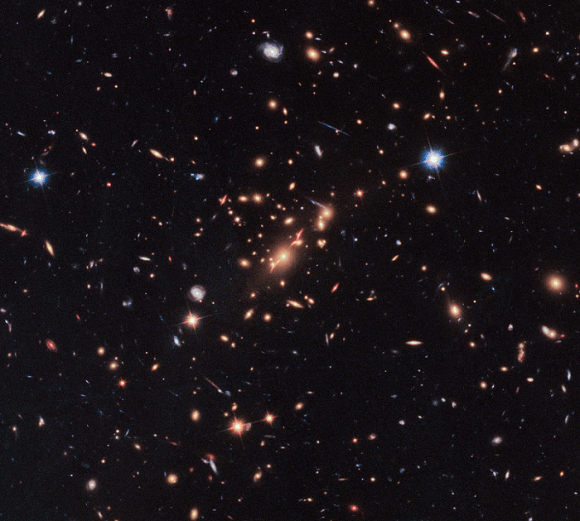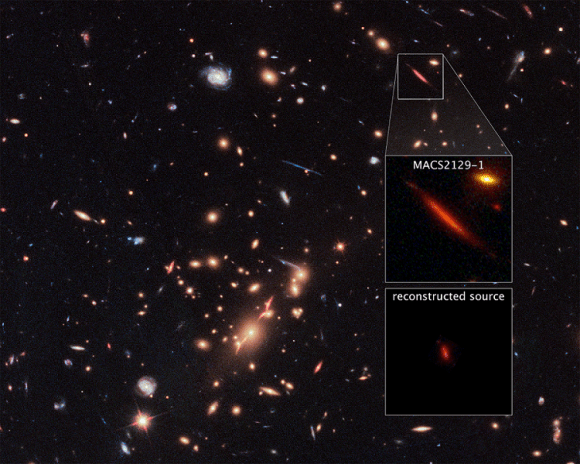Thanks to recent improvements in space-based and ground-based telescopes, astronomers have been able to probe deeper into the Universe than ever before. By looking billions of years back in time, we are able to test our theories about the history of galactic formation and evolution. Unfortunately, studying the very early Universe is a daunting task, and one that is beyond the capabilities of our current instruments.
But by combining the power of the Hubble Space Telescope with a technique known as gravitational lensing, a team of astronomers made the first discovery of a compact galaxy that stopped making stars just a few billion years after the Big Bang. The discovery of such a galaxy existing so early in the Universe is unprecedented and represents a major challenge to \theories of how massive galaxies form and evolve.
Their findings were reported in a study titled "A Massive, Dead Disk Galaxy in the Early Universe", which appeared in the June 22 issue of the journal Nature. As is indicated in the study, the team relied on data from Hubble which they combined with gravitational lensing - where a massive cluster of galaxies magnifies and stretches images of more distant galaxies beyond them - to study the distant galaxy known as MACS 2129-1.

Image of the Galaxy Cluster MACS J2129-0741, as part of CLASH. Credit: hubblesite.org
What they found was completely unexpected. Given the age of the galaxy - dated to just three billion years after the Big Bang - they expected to see a chaotic ball of stars that were forming due to early galaxies merging. Instead, they noticed that the galaxy, which was disk-shaped (like the Milky Way), was effectively dead - meaning that star formation had already ceased within it.
This was a surprise, seeing as how astronomers did not expect to see this so early in the Universe. What's more, it was the first time that direct evidence has been obtained that shows how at least some of the earliest "dead" galaxies in the Universe evolved from disk-shaped objects to become the giant elliptical galaxies that we regularly see in the Universe today.
As Sune Toft - a researcher from the Dark Cosmology Center at the Niels Bohr Institute and the lead author on the study - explained, this may force a rethink of how galaxies evolved in the early Universe:
"This new insight may force us to rethink the whole cosmological context of how galaxies burn out early on and evolve into local elliptical-shaped galaxies, Perhaps we have been blind to the fact that early "dead" galaxies could in fact be disks, simply because we haven't been able to resolve them."
In previous studies, it was assumed that distant dead galaxies were similar in structure to the local elliptical galaxies they eventually evolved into. Prior to this study, confirmation of this hypothesis was not possible since current instruments are not powerful enough to see that far into space. But by combining the power of gravitational lensing with Hubble's high resolution, Toft and his team were able to see this dead galaxy clearly.

Galaxy Cluster MACS J2129-0741 and Lensed Galaxy MACS2129- Credit: hubblesite.org
Combining rotational velocity measurements from the ESO's Very Large Telescope (VLT) with archival data from the Cluster Lensing And Supernova survey with Hubble (CLASH), they were able to determine the size of the galaxy, mass, and age as well as its (defunct) rate of star formation. Ultimately, they found that the remote galaxy is three times as massive as the Milky Way, though only half its size, and is spinning more than twice as fast.
Why this galaxy stopped forming stars is still unknown, and will require follow-up surveys using more sophisticated instruments. But in the meantime, there are some possible theories. For instance, it could be the result of an active galactic nucleus, where a supermassive black hole at the center of MACS 2129-1 inhibited star formation by heating the galaxy's gas and expelling it from the galaxy.
Or it may be the result of cold gas being streamed into the galaxy's center where it was rapidly heated and compressed, thereby preventing it from cooling and forming star-forming clouds. But when it comes to how these types of early, dead galaxies could have led to the elliptical galaxies we see today, Toft and his colleagues think they know the answer. As he explained, it could be through mergers:
"If these galaxies grow through merging with minor companions, and these minor companions come in large numbers and from all sorts of different angles onto the galaxy, this would eventually randomize the orbits of stars in the galaxies. You could also imagine major mergers. This would definitely also destroy the ordered motion of the stars."
In the coming years, Toft and his team hope to take advantage of the James Webb Telescope (which will be launching in 2018) to search for more early dead galaxies, in the hopes that it can shed light on the unresolved questions this discover raises. And with the ability to probe deeper into space, astronomers anticipate that a great deal more will be revealed about the early Universe.
Further Reading: Hubblesite, Nature
No comments:
Post a Comment